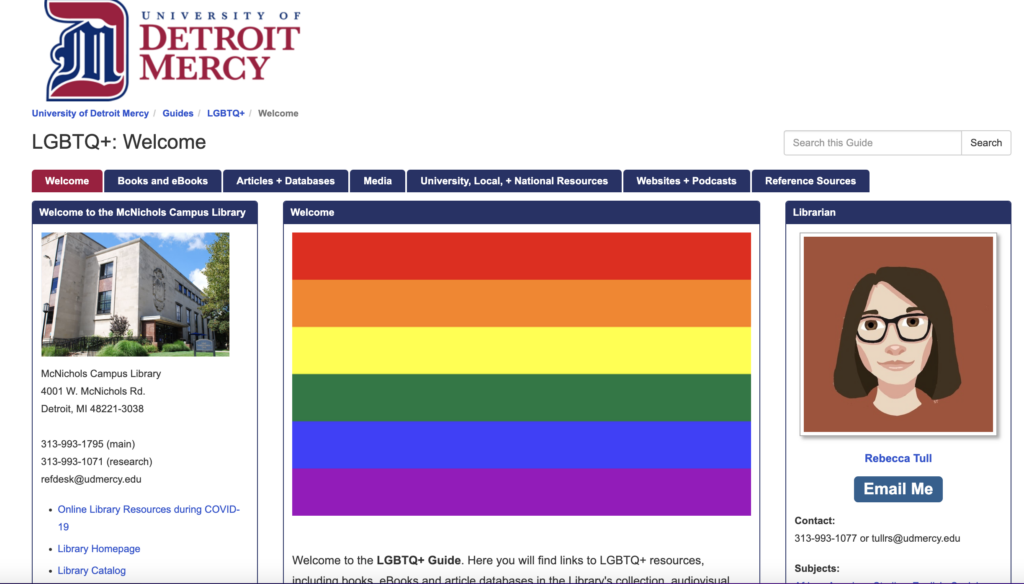An Interview with Megan Novell, Title IX Coordinator and Adjunct Faculty of English and Women’s and Gender Studies
By: Dr. Erin Bell, CETL Staff
At the University of Detroit Mercy and the Center for Excellence in Teaching & Learning, faculty and administrators frequently study, research, and consider methods for making their classrooms more inclusive. June is Pride Month but we can continue to review how to best support students who identify as LGBTQIA+ all year long. To this end, the CETL recently spoke with Megan Novell, Title IX Coordinator and Adjunct Faculty of English and Women’s and Gender Studies, about how faculty can continue to develop inclusive practices beyond adding an inclusion statement to their syllabus.
According to Novell, one quick and relatively easy way to assists students which is often overlooked is to direct students to make changes to their Personal Profile at my.udmercy.edu. Students can click on the Personal Information button to change their Preferred First Name, their Personal Pronoun, and their Gender Identification. This information will then automatically populate into course rosters and Blackboard shells so that students do not need to have multiple conversations with multiple professors.
“We put the preferred name policy in place and it isn’t just about gender identity which is one of its strengths,” explains Novell. “We have students who go by a name other than their legal first name for all kinds of reasons, unrelated to being a different gender than they were assigned at birth. There are lots of reasons students can elect to use a different name.” The profile tool allows students to share their identities with their instructors in an empowering manner which values choice and privacy. Students can choose how they wish to be introduced to their classmates before a course ever begins, and they do not have to publicly share their sexual identity with a room full of strangers.
Another suggestion that Novell offers is to conduct a first-day student survey. This can be implemented in an online or in-person course. Providing a survey can be an effective way of garnering information about students’ current understanding of course content, study habits and other pertinent information, but a survey can also include a brief section that asks students: is there anything else you would like me to know about you?
“That’s a really good question to pose,” notes Novell, “because it lets students indicate if they want to indicate a name, pronouns if they want to elect them, and to share all kinds of other things about themselves such as if they are a parent or if they have a mental health condition that might impact their work in the class. I think asking questions that are open-ended and where the answers are private is the best thing that faculty members can do to make students comfortable.”

The Detroit Mercy LGBTQ+ Library Guide offers a host of articles, links, and materials from local to national LGBTQ+ organizations. There are podcasts, media, books, and more for your review and use in the classroom.
In their attempts to be inclusive, many faculty may have encountered a strategy that asks that students share their pronouns on the first day of class. While the intentions behind this process may be good, such an activity may actually make students feel less comfortable. “This (activity) comes from a good place but also depends on the environment,” says Novell. “In our courses—most people are cisgender. . . may have conservative values, and now that everyone has just met, the one queer person in the room will identify themself.” As Novell explains, there are more subtle ways of garnering this information from students such as the strategies listed above.
 Photo by cottonbro: https://www.pexels.com/photo/persons-hands-with-rainbow-colors-3693901/
Photo by cottonbro: https://www.pexels.com/photo/persons-hands-with-rainbow-colors-3693901/
According to Novell, there are also methods for faculty to make sure their content and curriculum is inclusive as well. “Diversify your hypotheticals. If you have to use a hypothetical with names, put some same-sex couples in there, put some non-Anglo names in there. There is a deep list to draw from. Make those examples representative of our full student body.
Novell also suggests that pointing out where we find queer people in history can make a huge difference for students. “It doesn’t always have to be about someone’s personal life,” says Novell. “Just exploring the queer and the non-binary people in history and just foregrounding that they are there and have always been there is an important discussion.”
Additional resources are listed below, but if you would like to discuss how to make your classes more inclusive please contact the CETL for additional strategies and guidance.
Additional Resources:
https://www.hrc.org/campaigns/celebrate-pride-with-us
https://www2.ed.gov/about/offices/list/ocr/lgbt.html
https://www.glaad.org/resourcelist